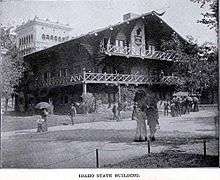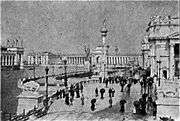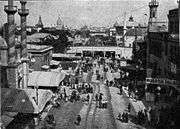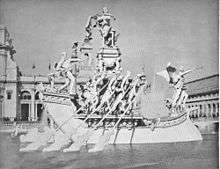World's Columbian Exposition
| EXPO Chicago 1893 | |
|---|---|
|
Chicago World's Columbian Exposition 1893, with the Republic statue and Administration Building | |
| Overview | |
| BIE-class | Universal exposition |
| Category | Historical |
| Name | World's Fair: Columbian Exposition |
| Area | 690 acres (280 ha) |
| Visitors | 27,300,000 |
| Participant(s) | |
| Countries | 46 |
| Location | |
| Country | United States |
| City | Chicago |
| Venue | Jackson Park and Midway Plaisance |
| Coordinates | 41°47′24″N 87°34′48″W / 41.79000°N 87.58000°W |
| Timeline | |
| Bidding | 1882 |
| Awarded | 1890 |
| Opening | May 1, 1893 |
| Closure | October 30, 1893 |
| Universal expositions | |
| Previous | Exposition Universelle (1889) in Paris |
| Next | Brussels International (1897) in Brussels |
The World's Columbian Exposition (the official shortened name for the World's Fair: Columbian Exposition,[1] also known as The Chicago World's Fair and Chicago Columbian Exposition) was a world's fair held in Chicago in 1893 to celebrate the 400th anniversary of Christopher Columbus's arrival in the New World in 1492.[2] The centerpiece of the Fair, the large water pool, represented the long voyage Columbus took to the New World. Chicago bested New York City; Washington, D.C.; and St. Louis for the honor of hosting the fair. The Exposition was an influential social and cultural event and had a profound effect on architecture, sanitation, the arts, Chicago's self-image, and American industrial optimism.
The layout of the Chicago Columbian Exposition was, in large part, designed by John Wellborn Root, Daniel Burnham, Frederick Law Olmsted and Charles B. Atwood[3][4] It was the prototype of what Burnham and his colleagues thought a city should be. It was designed to follow Beaux Arts principles of design, namely French neoclassical architecture principles based on symmetry, balance, and splendor. The color of the material generally used to cover the buildings facades gave the fairgrounds its nickname, the White City. Many prominent architects designed its 14 "great buildings". Artists and musicians were featured in exhibits and many also made depictions and works of art inspired by the exposition.
The exposition covered more than 600 acres (2.4 km2), featuring nearly 200 new (but purposely temporary) buildings of predominantly neoclassical architecture, canals and lagoons, and people and cultures from 46 countries.[2] More than 27 million people attended the exposition during its six-month run. Its scale and grandeur far exceeded the other world's fairs, and it became a symbol of the emerging American Exceptionalism, much in the same way that the Great Exhibition became a symbol of the Victorian era United Kingdom.
Dedication ceremonies for the fair were held on October 21, 1892, but the fairgrounds were not actually opened to the public until May 1, 1893. The fair continued until October 30, 1893. In addition to recognizing the 400th anniversary of the discovery of the New World by Europeans, the fair also served to show the world that Chicago had risen from the ashes of the Great Chicago Fire, which had destroyed much of the city in 1871.[2]
On October 9, 1893, the day designated as Chicago Day, the fair set a world record for outdoor event attendance, drawing 751,026 people. The debt for the fair was soon paid off with a check for $1.5 million (equivalent to $39,572,222 in 2015).[5] Chicago has commemorated the fair with one of the stars on its municipal flag.[6]
Planning and organization


Many prominent civic, professional, and commercial leaders from around the United States participated in the financing, coordination, and management of the Fair, including Chicago steel tycoon Charles H. Schwab, Chicago railroad and manufacturing magnate John Whitfield Bunn, and Connecticut banking, insurance, and iron products magnate Milo Barnum Richardson, among many others.[7]
The fair was planned in the early 1890s during the Gilded Age of rapid industrial growth, immigration, and class tension. World's fairs, such as London's 1851 Crystal Palace Exhibition, had been successful in Europe as a way to bring together societies fragmented along class lines.
The first American attempt at a world's fair in Philadelphia in 1876, drew crowds but was a financial failure. Nonetheless, ideas about distinguishing the 400th anniversary of Columbus' landing started in the late 1880s. Civic leaders in St. Louis, New York City, Washington DC and Chicago expressed an interest in hosting a fair to generate profits, boost real estate values, and promote their cities. Congress was called on to decide the location. New York's financiers J. P. Morgan, Cornelius Vanderbilt, and William Waldorf Astor, among others, pledged $15 million to finance the fair if Congress awarded it to New York, while Chicagoans Charles T. Yerkes, Marshall Field, Philip Armour, Gustavus Swift, and Cyrus McCormick, offered to finance a Chicago fair. What finally persuaded Congress was Chicago banker Lyman Gage, who raised several million additional dollars in a 24-hour period, over and above New York's final offer.[8]
The exposition corporation and national exposition commission settled on Jackson Park and an area around it as the fair site. Daniel H. Burnham was selected as director of works, and George R. Davis as director-general. Burnham emphasized architecture and sculpture as central to the fair and assembled the period's top talent to design the buildings and grounds including Frederick Law Olmsted for the grounds.[2] The temporary buildings were designed in an ornate Neoclassical style and painted white, resulting in the fair site being referred to as the “White City”.[8]
The Exposition's offices set up shop in the upper floors of the Rand McNally Building on Adams Street, the world's first all-steel-framed skyscraper. Davis's team organized the exhibits with the help of G. Brown Goode of the Smithsonian. The Midway was inspired by the 1889 Paris Universal Exposition, which included ethnological "villages".[9]
Civil rights leaders protested the refusal to include an African American exhibit. Frederick Douglass, Ida B. Wells, Irvine Garland Penn, and Ferdinand Lee Barnet coauthored a pamphlet entitled "The Reason Why the Colored American is not in the World's Columbian Exposition - The Afro-American's Contribution to Columbian Literature" addressing the issue. The exhibition included a number of exhibits put on by black individuals and approved by white organizers of the fair, including exhibits by the sculptor Edmonia Lewis, a painting exhibit by scientist George Washington Carver, and a statistical exhibit by John Imogen Howard. It also included blacks in white exhibits, such as Nancy Green's portrayal of the character, "Aunt Jemima" for the R. T. Davis Milling Company.[10]
Description
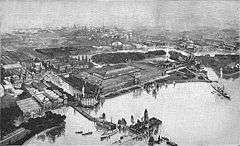
The fair opened in May and ran through October 30, 1893. Forty-six nations participated in the fair (it was the first world's fair to have national pavilions),[11] constructing exhibits and pavilions and naming national "delegates" (for example, Haiti selected Frederick Douglass to be its delegate).[12] The Exposition drew nearly 26 million visitors.
The exposition was located in Jackson Park and on the Midway Plaisance on 630 acres (2.5 km2) in the neighborhoods of South Shore, Jackson Park Highlands, Hyde Park and Woodlawn. Charles H. Wacker was the Director of the Fair. The layout of the fairgrounds was created by Frederick Law Olmsted, and the Beaux-Arts architecture of the buildings was under the direction of Daniel Burnham, Director of Works for the fair. Renowned local architect Henry Ives Cobb designed several buildings for the exposition. The Director of the American Academy in Rome, Francis Davis Millet, directed the painted mural decorations. Indeed, it was a coming-of-age for the arts and architecture of the "American Renaissance", and it showcased the burgeoning neoclassical and Beaux-Arts styles.
Attractions
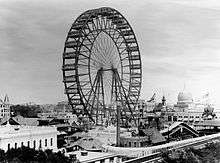

The World's Columbian Exposition was the first world's fair with an area for amusements that was strictly separated from the exhibition halls. This area, developed by a young music promoter, Sol Bloom, concentrated on Midway Plaisance and introduced the term "midway" to American English to describe the area of a carnival or fair where sideshows are located.[13]
It included carnival rides, among them the original Ferris Wheel, built by George Washington Gale Ferris Jr..[2] This wheel was 264 feet (80 m) high and had 36 cars, each of which could accommodate 40 people.[2][14] The importance of the Columbian Exposition is highlighted by the use of rueda de Chicago ("Chicago wheel") in many Latin American countries such as Costa Rica and Chile in reference to the Ferris wheel. One attendee, George C. Tilyou, later credited the sights he saw on the Chicago midway for inspiring him to create America's first major amusement park, Steeplechase Park in Coney Island, NY.
The fair included life-size reproductions of Christopher Columbus' three ships, the Niña, Pinta, and Santa Maria. These were intended to celebrate the 400th anniversary of Columbus' discovery of the Americas. The ships, a joint project of the governments of Spain and the United States, were constructed in Spain and then sailed to America for the exposition. The ships were a very popular exhibit.[15]
Eadweard Muybridge gave a series of lectures on the Science of Animal Locomotion in the Zoopraxographical Hall, built specially for that purpose on Midway Plaisance. He used his zoopraxiscope to show his moving pictures to a paying public. The hall was the first commercial movie theater.[16]
The "Street in Cairo" included the popular dancer known as Little Egypt.[17] She introduced America to the suggestive version of the belly dance known as the "hootchy-kootchy", to a tune said to have been improvised by Sol Bloom (and now more commonly associated with snake charmers) which he had composed when his dancers had no music to dance to.[18][19] Bloom did not copyright the song, putting it straight into the public domain.
Also included was the first moving walkway or travelator. It had two different divisions: one where passengers were seated, and one where riders could stand or walk. It ran in a loop down the length of a lakefront pier to a casino.
Although denied a spot at the fair, Buffalo Bill Cody decided to come to Chicago anyway, setting up his Wild West show just outside the edge of the exposition. Nearby, historian Frederick Jackson Turner gave academic lectures reflecting on the end of the frontier which Buffalo Bill represented.
The electrotachyscope of Ottomar Anschütz was demonstrated, which used a Geissler tube to project the illusion of moving images. Louis Comfort Tiffany made his reputation with a stunning chapel designed and built for the Exposition. This chapel has been carefully reconstructed and restored. It can be seen in at the Charles Hosmer Morse Museum of American Art.
Architect Kirtland Cutter's Idaho Building, a rustic log construction, was a popular favorite,[20] visited by an estimated 18 million people.[21] The building's design and interior furnishings were a major precursor of the Arts and Crafts movement.
Among the other attractions at the fair, several products that are well known today were introduced. These products included Juicy Fruit Gum, Cream of Wheat, and Pabst Blue Ribbon beer, among many others.
Anthropology
There was an Anthropology Building at the World's Fair. Nearby, "The Cliff Dwellers" featured a rock and timber structure that was painted to recreate Battle Rock Mountain in Colorado, a stylized recreation of American Indian cliff dwelling with pottery, weapons and other relics on display.[22] There was also an Eskimo display. There were also birch bark wigwams of the Penobscot tribe.
Rail
The John Bull locomotive was displayed. It was only 62 years old, having been built in 1831. It was the first locomotive acquisition by the Smithsonian Institution. The locomotive ran under its own power from Washington, DC, to Chicago to participate, and returned to Washington under its own power again when the exposition closed. In 1981 it was the oldest surviving operable steam locomotive in the world when it ran under its own power again.
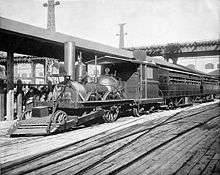
A Baldwin 2-4-2 locomotive was showcased at the exposition, and subsequently the 2-4-2 type was known as the Columbia
An original frog switch and portion of the superstructure of the famous 1826 Granite Railway in Massachusetts could be viewed. This was the first commercial railroad in the United States to evolve into a common carrier without an intervening closure. The railway brought granite stones from a rock quarry in Quincy, Massachusetts, so that the Bunker Hill Monument could be erected in Boston. The frog switch is now on public view in East Milton Square, Massachusetts, on the original right-of-way of the Granite Railway.

Country and state exhibition buildings
Forty-six countries had pavilions at the exposition.[2] Norway participated by sending the Viking, a replica of the Gokstad ship. It was built in Norway and sailed across the Atlantic by 12 men, led by Captain Magnus Andersen. In 1919 this ship was moved to Lincoln Park. It was relocated in 1996 to Good Templar Park in Geneva, Illinois, where it awaits renovation.[23][24]
United States states also had their own pavilions.[2] The work of noted feminist author Kate McPhelim Cleary was featured during the opening of the Nebraska Day ceremonies at the fair, which included a reading of her poem "Nebraska".[25] Four United States territories also had pavilions: Arizona, New Mexico, Oklahoma and Utah.[2]
Visitors to the Louisiana Pavilion were each given a seedling of a cypress tree. This resulted in the spread of cypress trees to areas where they were not native. Cypress trees from those seedlings can be found in many areas of West Virginia, where they flourish in the climate.[26] The Illinois was a detailed, full-scale mockup of an Indiana-class battleship, constructed as a naval exhibit.
Guns and artillery
%2C_1827-1909.jpg)
The German firm Krupp had a pavilion of artillery, which apparently had cost one million dollars to stage,[27] including a coastal gun of 42 cm in bore (16.54 inches) and a length of 33 calibres (45.93 feet, 14 meters). A breech-loaded gun, it weighed 120.46 long tons (122.4 metric tons). According to the company's marketing: "It carried a charge projectile weighing from 2,200 to 2,500 pounds which, when driven by 900 pounds of brown powder, was claimed to be able to penetrate at 2,200 yards a wrought iron plate three feet thick if placed at right angles."[28] Nicknamed "The Thunderer", the gun had an advertised range of 15 miles; on this occasion John Schofield declared Krupps' guns "the greatest peacemakers in the world".[27] This gun was later seen as a precursor of the company's World War I Dicke Berta howitzers.[29]
Religions
The 1893 Parliament of the World’s Religions, which ran from September 11 to September 27, marked the first formal gathering of representatives of Eastern and Western spiritual traditions from around the world. According to Eric J. Sharpe, Tomoko Masuzawa, and others, the event was considered radical at the time, since it allowed non-Christian faiths to speak on their own behalf; it was not taken seriously by European scholars until the 1960s.[30]
Moving walkway
Along the banks of the lake, patrons on the way to the casino were taken on a moving walkway, the first of its kind open to the public,[31] called The Great Wharf, Moving Sidewalk, it allowed people to walk along or ride in seats.[1]
Horticulture
Horticultural exhibits at the Horticultural Hall included cacti and orchids as well as other plants in a greenhouse.
Architectures
White City
Most of the buildings of the fair were designed in the neoclassical architecture style. The area at the Court of Honor was known as The White City. Facades were made not of stone, but of a mixture of plaster, cement, and jute fiber called staff, which was painted white, giving the buildings their "gleam". Architecture critics derided the structures as "decorated sheds". The buildings were clad in white stucco, which, in comparison to the tenements of Chicago, seemed illuminated. It was also called the White City because of the extensive use of street lights, which made the boulevards and buildings usable at night.
In 1892, working under extremely tight deadlines to complete construction, director of works Daniel Burnham appointed Francis Davis Millet to replace the fair's official director of color, William Pretyman. Pretyman had resigned following a dispute with Burnham. After experimenting, Millet settled on a mix of oil and white lead whitewash that could be applied using compressed air spray painting to the buildings, taking considerably less time than traditional brush painting.[32] Joseph Binks, maintenance supervisor at Chicago's Marshall Field's Wholesale Store, who had been using this method to apply whitewash to the subbasement walls of the store, got the job to paint the Exposition buildings.[33][34] Claims this was the first use of spray painting may be apocryphal since journals from that time note this form of painting had already been in use in the railroad industry from the early 1880s.[35]
Role in the City Beautiful Movement
%2C_1827-1909.jpg)
The White City is largely credited for ushering in the City Beautiful movement and planting the seeds of modern city planning. The highly integrated design of the landscapes, promenades, and structures provided a vision of what is possible when planners, landscape architects, and architects work together on a comprehensive design scheme.
The White City inspired cities to focus on the beautification of the components of the city in which municipal government had control; streets, municipal art, public buildings and public spaces. The designs of the City Beautiful Movement (closely tied with the municipal art movement) are identifiable by their classical architecture, plan symmetry, picturesque views, axial plans, as well as their magnificent scale. Where the municipal art movement focused on beautifying one feature in a city, the City Beautiful movement began to make improvements on the scale of the district. The White City of the World's Columbian Exposition inspired the Merchants Club of Chicago to commission Daniel Burnham to create the Plan of Chicago in 1909, which became the first modern comprehensive city plan in America.[36]
Great Buildings

There were fourteen main "great buildings"[37] centered around a giant reflective pool called the Grand Basin.[38] Buildings included:
- The Administration Building, designed by Richard Morris Hunt
- The Agricultural Building, designed by Charles McKim of McKim, Mead & White
- The Manufactures and Liberal Arts Building, designed by George B. Post. If this building were standing today, it would rank second in volume and third in footprint on list of largest buildings (130,000m2, 8,500,000m3).[18] It exhibited works related to literature, science, art and music.
- The Mines and Mining Building, designed by Solon Spencer Beman
- The Electricity Building, designed by Henry Van Brunt and Frank Maynard Howe
- The Machinery Hall, designed by Robert Swain Peabody of Peabody and Stearns
- The Woman's Building, designed by Sophia Hayden
- The Transportation Building, designed by Adler & Sullivan
- The Fisheries Building designed by Henry Ives Cobb[39]
- Forestry Building designed by Charles B. Atwood
- Horticultural Building designed by Jenney and Mundie
- Anthropology Building designed by Charles B. Atwood
Transportation Building
%2C_1827-1909.png)
Louis Sullivan's polychrome proto-Modern Transportation Building was an outstanding exception to the prevailing style, as he tried to develop an organic American form. Years later, in 1922, he wrote that the classical style of the White City had set back modern American architecture by forty years.[40]
As detailed in Erik Larson's popular history The Devil in the White City, extraordinary effort was required to accomplish the exposition, and much of it was unfinished on opening day. The famous Ferris Wheel, which proved to be a major attendance draw and helped save the fair from bankruptcy, was not finished until June, because of waffling by the board of directors the previous year on whether to build it. Frequent debates and disagreements among the developers of the fair added many delays. The spurning of Buffalo Bill's Wild West Show proved a serious financial mistake. Buffalo Bill set up his highly popular show next door to the fair and brought in a great deal of revenue that he did not have to share with the developers. Nonetheless, construction and operation of the fair proved to be a windfall for Chicago workers during the serious economic recession that was sweeping the country.[18]
Surviving structures
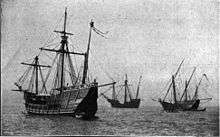
Almost all of the fair's structures were designed to be temporary; of the more than 200 buildings erected for the fair, the only two which still stand in place are the Palace of Fine Arts and the World's Congress Auxiliary Building. From the time the fair closed until 1920, the Palace of Fine Arts housed the Field Columbian Museum (now the Field Museum of Natural History, since relocated); in 1933 (having been completely rebuilt in permanent materials), the Palace building re-opened as the Museum of Science and Industry.[41] The second building, the World's Congress Building, was one of the few buildings not built in Jackson Park, instead it was built downtown in Grant Park. The cost of construction of the World's Congress Building was shared with the Art Institute of Chicago, which, as planned, moved into the building (the museum's current home) after the close of the fair.
Three other significant buildings survived the fair. The first is the Norway pavilion, a recreation of a traditional wooden stave church which is now preserved at a museum called Little Norway in Blue Mounds, Wisconsin. The second is the Maine State Building, designed by Charles Sumner Frost, which was purchased by the Ricker family of Poland Spring, Maine. They moved the building to their resort to serve as a library and art gallery. The Poland Spring Preservation Society now owns the building, which was listed on the National Register of Historic Places in 1974. The third is the Dutch House, which was moved to Brookline, Massachusetts.

The 1893 Viking ship that was sailed to the Exposition from Norway by Captain Magnus Andersen, is located in Geneva, Illinois. The ship is open to visitors on scheduled days April through October.[42]
The main altar at St. John Cantius in Chicago, as well as its matching two side altars, are reputed to be from the Columbian Exposition.
Since many of the other buildings at the fair were intended to be temporary, they were removed after the fair. The White City, so impressed visitors (at least before air pollution began to darken the façades) that plans were considered to refinish the exteriors in marble or some other material. These plans were abandoned in July 1894, when much of the fair grounds was destroyed in a fire.
Other architecture at the Fair
|
Visitors
Helen Keller, along with her mentor Anne Sullivan and Dr. Alexander Graham Bell, visited the fair in summer of 1893. Keller described the fair in her autobiography "The Story of My Life". [43] Early in July, a Wellesley College English teacher named Katharine Lee Bates visited the fair. The White City later inspired the reference to "alabaster cities" in her poem "America the Beautiful".[44] The exposition was extensively reported by Chicago publisher William D. Boyce's reporters and artists.[45] There is a very detailed and vivid description of all facets of this fair by the Persian traveler Mirza Mohammad Ali Mo'in ol-Saltaneh written in Persian. He departed from Persia on April 20, 1892, especially for the purpose of visiting the World's Columbian Exposition.[46] Pierre de Coubertin visited the fair with his friends Paul Bourget and Samuel Jean de Pozzi. He devotes the first chapter of his book " Souvenirs d'Amérique et de Grèce " (1897) to the visit. Swami Vivekananda visited the fair to attend the Parliament of the World's Religions and delivered his famous speech "Sisters and brothers of America!".[47]
Souvenirs

Examples of exposition souvenirs can be found in various American museum collections. One example, copyrighted in 1892 by John W. Green, is a folding hand fan with detailed illustrations of landscapes and architecture.[48] Charles W Goldsmith produced a set of ten postcard designs, each in full colour, showing the buildings constructed for the exhibition.[49]Columbian Exposition coins were also minted for the event.
Assassination and end of fair
The fair ended with the city in shock, as popular mayor Carter Harrison, Sr. was assassinated by Patrick Eugene Prendergast two days before the fair's closing. Closing ceremonies were canceled in favor of a public memorial service.
Jackson Park was returned to its status as a public park, in much better shape than its original swampy form. The lagoon was reshaped to give it a more natural appearance, except for the straight-line northern end where it still laps up against the steps on the south side of the Palace of Fine Arts/Museum of Science & Industry building. The Midway Plaisance, a park-like boulevard which extends west from Jackson Park, once formed the southern boundary of the University of Chicago, which was being built as the fair was closing (the university has since developed south of the Midway). The university's football team, the Maroons, were the original "Monsters of the Midway". The exposition is mentioned in the university's alma mater: "The City White hath fled the earth,/But where the azure waters lie,/A nobler city hath its birth,/The City Gray that ne'er shall die."
Electricity at the fair
.jpg)

The effort to power the Fair with electricity, which became a demonstration piece for Westinghouse Electric and the alternating current system they had been developing for many years, took place at the end of what has been called the War of the currents between DC and AC.[50] Westinghouse initially did not put in a bid to power the Fair but agreed to be the contractor for a local Chicago company that put in a low bid of US$510,000 to supply an alternating current based system.[51] Edison General Electric, which at the time was merging with the Thomson-Houston Electric Company to form General Electric, put in a US$1,720,000 bid to power the Fair and its planned 93,000 incandescent lamps with direct current. After the Fair committee went over both proposals Edison General Electric re-bid their costs at $554,000 but Westinghouse under bid them by 70 cents per lamp to get the contract.[51][52] Westinghouse could not use the Edison incandescent lamp since the patent belonged to General Electric and they had successfully sued to stop use of all patent infringing designs. Since Edison specified a sealed globe of glass in his design Westinghouse found a way to sidestep the Edison patent by quickly developing a lamp with a ground glass stopper in one end, based on a Sawyer-Man "stopper" lamp patent they already had. The lamps worked well but were short lived, requiring a small army of workmen to constantly replace them.[53] Westinghouse Electric had severely underbid the contract and struggled to supply all the equipment specified including twelve 1,000 horsepower single phase AC generators and all the lighting and other equipment required.[54] They also had to fend off a last minute lawsuit by General Electric claiming the Westinghouse Sawyer-Man based stopper lamp infringed on the Edison incandescent lamp patent.[55]
The International Exposition held an Electricity Building which was devoted to electrical exhibits. A statue of Benjamin Franklin was displayed at the entrance. The exposition featured interior and exterior light and displays as well as displays of Thomas Edison's kinetoscope, search lights, a seismograph, electric incubators for chicken eggs,[56] and Morse code telegraph.[57]
All the exhibits were from commercial enterprises. Participants included General Electric, Brush, Western Electric, and Westinghouse. The Westinghouse Company displayed several polyphase systems. The exhibits included a switchboard, polyphase generators, step-up transformers, transmission line, step-down transformers, commercial size induction motors and synchronous motors, and rotary direct current converters (including an operational railway motor). The working scaled system allowed the public a view of a system of polyphase power which could be transmitted over long distances, and be utilized, including the supply of direct current. Meters and other auxiliary devices were also present.
Part of the space occupied by the Westinghouse Company was devoted to demonstrations of electrical devices developed by Nikola Tesla[58] including a two-phase induction motor, and generators to power the system.[59] Tesla demonstrated a series of electrical effects, some which were in previous lectures performed in America and Europe.[60] This included using high-voltage, high-frequency alternating current to light a wireless gas-discharge lamp.[60]
Also at the Fair, the Chicago Athletic Association Football team played one of the very first night football games against West Point (the earliest being on September 28, 1892 between Mansfield State Normal and Wyoming Seminary). Chicago won the game 14-0. The game lasted only 40 minutes, compared to the normal 90 minutes.[61]
Music at the fair
Musicians
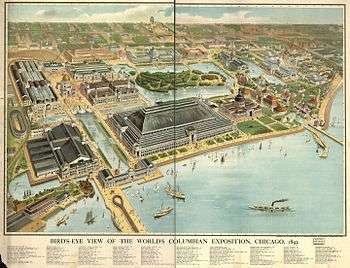
- Joseph Douglass, classical violinist, who achieved wide recognition after his performance there and became the first African-American violinist to conduct a transcontinental tour and the first to tour as a concert violinist.[62][63]
- Sissieretta Jones, a soprano known as "the Black Patti" and an already-famous opera singer.[64]
- A paper on African-American spirituals and shouts by Abigail Christensen was read to attendees.[65]
There were many other black artists at the fair, ranging from minstrel and early ragtime groups to more formal classical ensembles to street buskers.
- Scott Joplin, pianist, from Texarkana, TX; became widely known for his piano playing at the fair.
Other music and musicians
- John Philip Sousa′s Band played for the Exposition dedication celebration in Chicago, 10 October through 21 October 1892.
- The first Indonesian music performance in the United States was at the exposition.[66] The gamelan instruments used in the performance were later placed in the Field Museum of Natural History.
- A group of hula dancers led to increased awareness of Hawaiian music among Americans throughout the country.[67]
- Stoughton Musical Society, the oldest choral society in the United States, presented the first concerts of early American music at the exposition.
- The first eisteddfod (a Welsh choral competition with a history spanning many centuries) held outside Wales was held in Chicago at the exposition.
- A 250-voice Mormon Tabernacle Choir competed in the Eisteddfod taking the second place prize of $1000. This was the first appearance of the Choir outside the Utah territory.
- August 12, 1893 – Antonín Dvořák conducted a gala "Bohemian Day" concert at the exposition, besieged by visitors including the conductor of the Chicago Symphony, who arranged for performance of the "American" String Quartet, just completed in Spillville, Iowa, during a Dvořák family vacation in a Czech-speaking community there.[68]
- American Composer Amy Cheney Beach (1867-1944) was commissioned by the Board of Lady Managers of the fair to compose a choral work (Festival Jubilate, op. 17) for the opening of the Woman's Building.[69]
- Sousa′s Band played concerts in the south bandstand on the Great Plaza, 25 May to 28 June 1893.
- The University of Illinois Military Band conducted by student leaders Charles Elder and Richard Sharpe played concerts twice daily in the Illinois Building 9 June to 24 June 1893. Soloists were William Sandford, euphonium; Charles Elder, clarinet; William Steele, cornet. The band members slept on cots on the top floor of the building.
- 8 June 1893 — The Exposition Orchestra, an expanded version of the Chicago Symphony conducted by guest conductor Vojtěch I. Hlaváč, played the American premier of Modest Mussorgsky's "A Night on Bald Mountain" as part of a concert of Russian folk music.[70]
Art at the fair
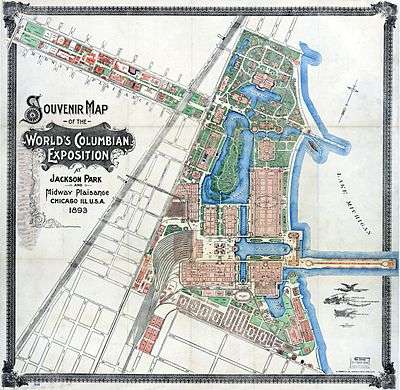
American artists
- Mary Cassat, painter ("Modern Woman Mural" in Palace of Fine Arts Bldg.).[71]
- Sarah Paxton Ball Dodson [72]
- William Rudolf O'Donovan
- George D. Peterson
- Carol Brooks MacNeil
- Helen Farnsworth Mears [73]
- Mary Lawrence [74]
- Preston Powers
- Katherine Prescott
- Gari Melchers
- Louis Moeller
- Edward Moran
- John Harrison Mills
- Theo Alice Ruggles Kitson [75]
- Charles Morgan McIlhenney
- Anna Lea Merritt [76]
- Robert Crannell Minor
- Peter Moran
- Harry Humphrey Moore
- Aloys Loeher
- Theodore Dreiser
Women artists at the Women's Building
The women artists at the Women's Building included Viennese painter Rosa Schweninger, and many others.[77] American composer Amy Cheney Beach was commissioned by the Board of Lady Managers of the fair to compose a choral work (Festival Jubilate, op. 17) for the opening of the Woman's Building.[69]
Notable firsts at the fair
Concepts

- Frederick Jackson Turner lectured on his Frontier thesis.[78]
- The Pledge of Allegiance was first performed at the exposition by a mass of school children lined up in military fashion.[79]
- Contribution to Chicago's nickname, the "Windy City". Some argue that Charles Anderson Dana of the New York Sun coined the term related to the hype of the city's promoters. Other evidence, however, suggests the term was used as early as 1881 in relation to either Chicago's "windbag" politicians or to its weather.[18]
Commemorations
- United States Mint offered its first commemorative coins: a quarter and half dollar[80]
- The United States Post Office Department produced its first picture postcards and Commemorative stamp set[81]
Edibles and potables
- Cream of Wheat
- Milton Hershey bought a European exhibitor's chocolate manufacturing equipment and added chocolate products to his caramel manufacturing business
- Juicy Fruit gum
- Quaker Oats
- Shredded Wheat[82]
- Pabst Blue Ribbon
- Aunt Jemima pancake mix was widely popularized by spokesperson Nancy Green's pancake cooking and story telling performances.[83]
Inventions and manufacturing advances
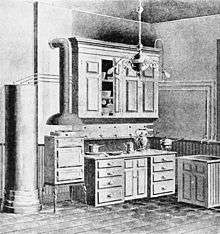
- A device that made plates for printing books in Braille, unveiled by Frank Haven Hall, who met Helen Keller and her teacher Anne Sullivan at the exhibit.[18]
- Moving walkway, or travelator
- The third rail giving electric power to elevated trains led directly to its first continuing US use.[84]
- The "clasp locker," a clumsy slide fastener and forerunner to the zipper was demonstrated by Whitcomb L. Judson
- Elongated coins (the squashed penny)
- Ferris Wheel
- First fully electrical kitchen including an automatic dishwasher[18]
- Phosphorescent lamps (a precursor to fluorescent lamps)[18]
- John T. Shayne & Company, the local Chicago furrier helped America gain respect on the world stage of manufacturing
Organizations
- Congress of Mathematicians,[85] precursor to International Congress of Mathematicians
- Interfaith dialogue (the Parliament of the World’s Religions)
Performances
- The poet and humorist Benjamin Franklin King, Jr. first performed at the exposition.
Later years
| Postal memorabilia | |
|---|---|
| |
The exposition was one influence leading to the rise of the City Beautiful movement.[86] Results included grand buildings and fountains built around Olmstedian parks, shallow pools of water on axis to central buildings, larger park systems, broad boulevards and parkways and, after the start of the 20th century, zoning laws and planned suburbs. Examples of the City Beautiful movement's works include the City of Chicago, the Columbia University campus, and the National Mall in Washington D.C.
After the fair closed, J.C. Rogers, a banker from Wamego, Kansas, purchased several pieces of art that had hung in the rotunda of the U.S. Government Building. He also purchased architectural elements, artifacts and buildings from the fair. He shipped his purchases to Wamego. Many of the items, including the artwork, were used to decorate his theater, now known as the Columbian Theatre.
Memorabilia saved by visitors can still be purchased. Numerous books, tokens, published photographs, and well-printed admission tickets can be found. While the higher value commemorative stamps are expensive, the lower ones are quite common. So too are the commemorative half dollars, many of which went into circulation.
Although not available for purchase, The George Washington University maintains a small collection of exposition tickets for viewing and research purposes. The collection is currently cared for by GWU's Special Collections Research Center, located in the Estelle and Melvin Gelman Library.[87]
When the exposition ended the Ferris Wheel was moved to Chicago's north side, next to an exclusive neighborhood. An unsuccessful Circuit Court action was filed against the owners of the wheel to have it moved. The wheel stayed there until it was moved to St. Louis for the 1904 World's Fair.[45]
See also
- List of world expositions
- List of world's fairs
- Benjamin W. Kilburn, stereoscopic view concession and subsequent views of the Colombian World's Exposition.
- Herman Webster Mudgett, serial killer associated with the 1893 World's Fair
- St. John Cantius in Chicago, whose main altar, as well as its matching two side altars, reputedly originate from the 1893 Columbian Exposition
- Spectacle Reef Light
- World's Largest Cedar Bucket
- Fairy lamp, candle sets popularized at Queen Victoria's Golden Jubilee were used to illuminate an island at the Expo
- Media about the fair
- 1893: A World's Fair Mystery, an interactive fiction by Peter Nepstad that recreates the Exposition in detail
- Against the Day, a fictional novel that takes place during the Exposition during the first act.
- Devil in the White City, a non-fiction book intertwining the true tales of the architect behind the 1893 World's Fair and serial killer H. H. Holmes
- Expo: Magic of the White City, a documentary film about the exposition
- Jimmy Corrigan, the Smartest Kid on Earth, a graphic novel set in part at the Chicago World's Columbian Exposition of 1893
- Wonder of the Worlds, an adventure novel where Nikola Tesla, Mark Twain and Houdini pursue Martian agents who have stolen a powerful crystal from Tesla at the Columbia Exposition
References and notes
- General
- Crawford, Richard (2001). America's Musical Life: A History. W. W. Norton & Company. ISBN 0-393-04810-1.
- Southern, Eileen (1997). Music of Black Americans. New York: W.W. Norton & Co. ISBN 0-393-03843-2.
- Petterchak, Janice A. (2003). Lone Scout: W. D. Boyce and American Boy Scouting. Rochester, Illinois: Legacy Press. ISBN 0-9653198-7-3.
- Neuberger, Mary. 2006. "To Chicago and Back: Alecko Konstantinov, Rose Oil, and the Smell of Modernity" in Slavic Review, Fall 2006.
- Larson, Erik. The Devil in the White City: Murder, Magic, and Madness at the Fair That Changed America. New York: Vintage Books a Division of Random House, Inc., 2003.
- Ramsland, Katherine. “H. H. Holmes: Master of Illusion”. crime library. 2014. October 1, 2014.
- Redman, Samuel J. Bone Rooms: From Scientific Racism to Human Prehistory in Museums. Cambridge: Harvard University Press. 2016.
- Placko, Dane. “Chilling Tour inside Serial Killer H. H. Holmes’ ‘Murder Castle’”. My Fox Chicago. Apr. 28, 2014. Oct 2, 2014.
- French, Leanne; Grimm, Laura; Pak, Eudie. “H. H. Holmes Biography”. Biography. 2014. October 1, 2014.
- French, Leanne; Grimm, Laura; Pak, Eudie. H. H. Holmes – The World Fair. Television clip. Biography. 2014. A&E Television Networks, LLC, 2014. Video from biography.com.
- French, Leanne; Grimm, Laura; Pak, Eudie. H. H. Holmes – Chicago Expansion. Television clip. Biography. 2014. A&E Television Networks, LLC, 2014. Video from biography.com.
- French, Leanne; Grimm, Laura; Pak, Eudie. H. H. Holmes – Finding the Victims. Television Clip. Biography. 2014. A&E Television Networks, LLC, 2014. Video from biography.com.
- French, Leanne; Grimm, Laura; Pak, Eudie. H. H. Holmes – Full Biography. Television clip. Biography. 2014. A&E Television Networks, LLC, 2014. Video from biography.com.
- Citations
- 1 2 Truman, Benjamin (1893). History of the World's Fair: Being a Complete and Authentic Description of the Columbian Exposition From Its Inception. Philadelphia, PA: J. W. Keller & Co.
- 1 2 3 4 5 6 7 8 9 "Bird's-Eye View of the World's Columbian Exposition, Chicago, 1893". World Digital Library. 1893. Retrieved 2013-07-17.
- ↑ "World's Columbian Exposition". Encyclopædia Britannica. Retrieved 14 November 2016.
- ↑ Lawson, Erik (2003). The Devil in the White City: Murder, Magic, and Madness at the Fair that Changed America. New York: Vintage Books. ISBN 0-609-60844-4.
- ↑ Lawson, Erik (2003). The Devil in the White City: Murder, Magic, and Madness at the Fair that Changed America. New York: Vintage Books. pp. 318–320. ISBN 0-609-60844-4.
- ↑ "Municipal Flag of Chicago". Chicago Public Library. 2009. Retrieved 2009-03-04.
- ↑ Moses Purnell Handy, "The Official Directory of the World's Columbian Exposition, May 1st to October 30th, 1893: A Reference Book of Exhibitors and Exhibits, and of the Officers and Members of the World's Columbian Commission Books of the Fairs" (William B. Conkey Co., 1893) P. 75 (See: Google Books). See also: Memorial Volume. Joint Committee on Ceremonies, Dedicatory And Opening Ceremonies of the World's Columbian Exposition: Historical and Descriptive, A. L. Stone: Chicago, 1893. P. 306.
- 1 2 "World's Columbian Exposition", Encyclopedia of Chicago
- ↑ "World's Columbian Exposition: The Official Fair--A History".
- ↑ see introduction of 2013 edition of Rydell, Robert W. All the world's a fair: Visions of empire at American international expositions, 1876-1916. University of Chicago Press, 2013.
- ↑ Birgit Breugal for the EXPO2000 Hannover GmbH Hannover, the EXPO-BOOK The Official Catalogue of EXPO2000 with CDROM
- ↑ Rydell, Robert W. (1987).All the World's a Fair: Visions of Empire at American International Expositions, p. 53. University of Chicago. ISBN 0-226-73240-1.
- ↑ Harper, Douglas. "midway". Chicago Manual Style (CMS). Online Etymology Dictionary. Retrieved 12 April 2013.
- ↑ Buel, James William. ‘’The Magic City: A Massive Portfolio of Original Photographic Views of the Great World’s Fair’’, Historical Publishing Company, St. Louis MO, 1894 reprinted by Arno Press, NY, 1974
- ↑ Trumble White, William Iglehart, and George R. Davis, The World's Columbian Exposition, Chicago 1893 (1893), at 493; James C. Clark, "What Happened to the Nina, Pinta and Santa Maria that Sailed in 1892?", Orlando Sentinel, May 10, 1992.
- ↑ Clegg, Brian (2007). The Man Who Stopped Time. Joseph Henry Press. ISBN 0-309-10112-3.
- ↑ "The World's Columbian Exposition (1893)". The American Experience. PBS. 1999. Retrieved 2009-12-21.
- 1 2 3 4 5 6 7 Larson, Erik (2003). The Devil in the White City: Murder, Magic and Madness at the Fair that Changed America. New York, NY: Crown. ISBN 0-609-60844-4.
- ↑ Adams, Cecil (2007-02-27). "What is the origin of the song "There's a place in France/Where the naked ladies dance?" Are bay leaves poisonous?". The Straight Dope. Retrieved 2009-12-21.
- ↑ HistoryLink Essay: Cutter, Kirtland Kelsey
- ↑ "Arts & Crafts Movement Furniture".
- ↑ Chicago's 1893 World's Fair by Joseph M. Di Cola, David Stone page 21
- ↑ Nepstad, Peter. "The Viking Shop in Jackson Park" (pdf). Hyde Park Historical Society. Retrieved 2009-01-24.
- ↑ Smith, Gerry (2008-06-26). "Viking ship from 1893 Chicago world's fair begins much-needed voyage to restoration". Chicago Tribune. Tribune Company. Retrieved 2009-01-24.
- ↑ "Kate McPhelim Cleary: A Gallant Lady Reclaimed" Lopers.net. Accessed October 6, 2008.
- ↑ Wonderful West Virginia magazine, August 2007 at pg. 6
- 1 2 Chaim M. Rosenberg (2008). America at the fair: Chicago's 1893 World's Columbian Exposition. Arcadia Publishing. pp. 229–230. ISBN 978-0-7385-2521-1.
- ↑ John Birkinbine (1893) "Prominent Features of the World's Columbian Exposition", Engineers and engineering, Volume 10, p. 292; for the metric values see Ludwig Beck (1903). Die geschichte des eisens in technischer und kulturgeschiehtlicher beziehung: abt. Das XIX, jahrhundert von 1860 an bis zum schluss. F. Vieweg und sohn. p. 1026.
- ↑ Hermann Schirmer (1937). Das Gerät der Artillerie vor, in und nach dem Weltkrieg: Das Gerät der schweren Artillerie. Bernard & Graefe. p. 132.
Der Schritt von einer kurze 42-cm-Kanone L/33 zu einer Haubitze mit geringerer Anfangsgeschwindigkeit und einem um etwa 1/5 geringeren Geschossgewicht war nich sehr gross.
- ↑ Masuzawa, Tomoko (2005). The Invention of World Religions. Chicago University of Chicago Press. pp. 270–274. ISBN 978-0-226-50989-1.
- ↑ Bolotin, Norman, and Christine Laing. The World's Columbian Exposition: the Chicago World's Fair of 1893. Chicago: University of Illinois Press, 2002.
- ↑ "The Devil in the White City" by Erik Larson, Vintage, 2004
- ↑ finishingacademy.com, 1.1.1 The History of the Spray Booth
- ↑ http://www.bodyshopbusiness.com/the-history-of-sprayguns/
- ↑ Whet Moser, The Contentious Historical Origins of Spray Paint, chicagomag.com, Nov. 7, 2011
- ↑ Levy, John M. (2009) Contemporary Urban Planning.
- ↑ Chicago's 1893 World's Fair by Joseph M. Di Cola, David Stone page 17
- ↑ Keene, Jennifer (2013). Visions of America: A History of the United States Since 1865. London: Pearson. pp. 508, 510. ISBN 978-0205251636.
- ↑ Chicago's 1893 World's Fair by Joseph M. Di Cola and David Stone page 23
- ↑ Sullivan, Louis (1924). Autobiography of an Idea. New York City: Press of the American institute of Architects, Inc.. p. 325.
- ↑ About The Museum - Museum History - Museum of Science and Industry, Chicago, USA
- ↑ "Friends of the Viking Ship".
- ↑ "The Story of My Life.". digital.library.upenn.edu. Retrieved 2016-01-03.
- ↑ "Falmouth Museums on the Green", Falmouth Historical Society
- 1 2 Petterchak 2003, pp. 17–18
- ↑ Muʿīn al-Salṭana, Muḥammad ʿAlī (Hāǧǧ Mīrzā), Safarnāma-yi Šīkāgū : ḵāṭirāt-i Muḥammad ʿAlī Muʿīn al-Salṭana bih Urūpā wa Āmrīkā : 1310 Hiǧrī-yi Qamarī / bih kūšiš-i Humāyūn Šahīdī, [Tihrān] : Intišrāt-i ʿIlmī, 1984, 1363/[1984].
- ↑ http://www.swamivivekanandaquotes.org/2014/05/sisters-and-brothers-of-america.html
- ↑ "Fan". Online Collections Database. Staten Island Historical Society. Retrieved 6 January 2014.
- ↑ Willoughby, Martin (1992). A History of Postcards. London England: Bracken Books. p. 42. ISBN 1858911621.
- ↑ "The World's Columbian Exposition".
- 1 2 Richard Moran, Executioner's Current: Thomas Edison, George Westinghouse, and the Invention of the Electric Chair, Knopf Doubleday Publishing Group - 2007, page 97
- ↑ Quentin R. Skrabec, George Westinghouse: Gentle Genius, pages 135-137
- ↑ Quentin R. Skrabec, George Westinghouse: Gentle Genius, page 140
- ↑ L. J. Davis, Fleet Fire: Thomas Edison and the Pioneers of the Electric Revolution, Skyhorse Publishing - 2012, Chapter 8: The Manufacture and the Magus
- ↑ Quentin R. Skrabec, George Westinghouse: Gentle Genius, page 142
- ↑ http://www.pbs.org/wgbh/amex/chicago/peopleevents/e_court.html
- ↑ Chicago's 1893 World's Fair by Joseph M. Di Cola, David Stone page 22
- ↑ Marc Seifer, Wizard: The Life and Times of Nikola Tesla - Page 1744
- ↑ Electricity at the Columbian Exposition. By John Patrick Barrett. p165-170.
- 1 2 "Tesla".
- ↑ Pruter, Robert (2005). "Chicago Lights Up Football World" (PDF). LA 4 Foundation. XVIII (II): 7–10.
- ↑ Southern, pg. 283
- ↑ Caldwell Titcomb (Spring 1990). "Black String Musicians: Ascending the Scale". Black Music Research Journal. Center for Black Music Research - Columbia College Chicago and University of Illinois Press. 10 (1): 107–112. doi:10.2307/779543. JSTOR 779543.
- ↑ Terry Waldo (1991). This is Ragtime. Da Capo Press.
- ↑ Brunvand, Jan Harold (1998). "Christensen, Abigail Mandana ("Abbie") Holmes (1852-1938)". American folklore: an encyclopedia. Taylor & Francis. p. 142. ISBN 978-0-8153-3350-0.
- ↑ Diamond, Beverly; Barbara Benary. "Indonesian Music". The Garland Encyclopedia of World Music. pp. 1011–1023.
- ↑ Stillman, Amy Ku'uleialoha. "Polynesian Music". The Garland Encyclopedia of World Music. pp. 1047–1053.
- ↑ "Dvořák in America". DVOŘÁK AMERICAN HERITAGE ASSOCIATION. Retrieved 2015-12-07.
- 1 2 Brittain, Randy Charles. "Festival Jubilate, Op. 17 by Amy Cheney Beach (1867-1944): A Performing Edition." Ph.D. Dissertation: University of North Carolina, Greensboro, 1994.
- ↑ Program notes by Phillip Huscher for a performance by the Chicago Symphony Orchestra conducted by Riccardo Muti at the Krannert Center for the Performing Arts, Urbana, Ill. 24 September 2016. pp. 6-7.
- ↑ "Women's Building: 1893 World's Exposition". Women's Art at the World's Columbian Fair & Exposition, Chicago 1893. Retrieved 2014-11-09.
- ↑ "United States Women Painters: 1893 Exposition - page 4". Women's Art at the World's Columbian Fair & Exposition, Chicago 1893. Retrieved 2014-11-09.
- ↑ Opitz, ed., Glenn B. (1984). Dictionary of American Sculptors: 18th century to the present. New York: Apollo. p. 268. ISBN 0938290037.
- ↑ "Chicago - Columbus Landing on San Salvador".
- ↑ National Museum of American Art; National Portrait Gallery (Smithsonian Institution) (1993). Revisiting the white city: American art at the 1893 World's Fair. Washington, D.C. : Hanover: National Museum of American Art and National Portrait Gallery, Smithsonian Institution ; Distributed by the University Press of New England. pp. [82, 376]. ISBN 0937311014.
- ↑ "United States Women Painters: 1893 Exposition, page 8". Women's Art at the World's Columbian Fair & Exposition, Chicago 1893. Retrieved 2014-11-09.
- ↑ "Austrian Women Painters: 1893 Chicago World's Fair & Exposition". Women's Art at the World's Columbian Fair & Exposition, Chicago 1893. Retrieved 2014-11-09.
- ↑ "Frederick Jackson Turner". Pbs.com. PBS. Retrieved 27 March 2014.
- ↑ Giddings, Paula (2008). Ida: A Sword Among Lions. HarperCollins. p. 270. ISBN 978-0-06-051921-6.
- ↑ "Commemoratives from 1892-1954". The United States Mint,gov. Retrieved 20 February 2014.
- ↑ "The Columbian Exposition and the Nation's First Commemorative Stamps". National Postal Museum. National Postal Museum. Retrieved 27 March 2014.
- ↑ Hill, Genna (Sep 24, 2010). The 2011 Chicago North Side Real Estate Guide: Bucktown, Wicker Park, Lincoln Park, Lake View, Gold Coast, Streeterville. Andersonville, Wrigleyville, Ravenswood and More. Wexford House Books. pp. 73–74.
- ↑ Giddings, Paula (2008). Ida: A Sword Among Lions. HarperCollins. p. 273. ISBN 978-0-06-051921-6.
- ↑ 'The Chicago "L" by Greg Borzo
- ↑ Robert de Boer (2009) Alexander Macfarlane in Chicago, 1893 from WebCite
- ↑ Talen, Emily (2005).New Urbanism and American Planning: The Conflict of Cultures, p. 118. Routledge. ISBN 0-415-70133-3.
- ↑ Guide to the World's Columbian Exposition Ticket Collection, 1893, Special Collections Research Center, Estelle and Melvin Gelman Library, The George Washington University
Further reading
|
|
External links
| Wikimedia Commons has media related to: |
| Library resources about World's Columbian Exposition |
| Wikisource has original text related to this article: |
- Media on Wikipedia Common for the Columbian Exposition
- The Columbian Exposition in American culture.
- Photographs of the 1893 Columbian Exposition
- Photographs of the 1893 Columbian Exposition from Illinois Institute of Technology
- Interactive map of Columbian Exposition
- The Story of the Columbian Expo Battleship Illinois Bell
- President Benjamin Harrison: Celebrating the 400th Anniversary of the Discovery of America Shapell Manuscript Foundation
- "Expo: Magic of the White City," a documentary about the World's Columbian Exposition narrated by Gene Wilder
- The 1893 World's Columbian Exposition Reading Room.
- A large collection of stereoviews of the fair
- The Winterthur Library Overview of an archival collection on the World's Columbian Exposition.
- Columbian Theatre History and information about artwork from the U.S. Government Building.
- Photographs and interactive map from the 1893 Columbian Exposition from the University of Chicago
- Video simulations from the 1893 Columbian Exposition from UCLA's Urban Simulation Team
- 1893 Columbian Exposition Concerts
- Edgar Rice Burroughs' Amazing Summer of '93 - Columbian Exposition
- International Eisteddfod chair, Chicago, 1893
- Photographs of the Exposition from the Hagley Digital Archives
- 1893 Chicago World Columbia Exposition: A Collection of Digitized Books from the University of Illinois at Urbana-Champaign
- Map of Chicago Columbian Exposition from the American Geographical Society Library
- Interactive Map of the Chicago Columbian Exposition, created in the Harvard Worldmap Platform
- President Harrison: Worlds Columbian Exposition Shapell Manuscript Foundation
- Guide to the World's Columbian Exposition Ticket Collection, 1893, Special Collections Research Center, Estelle and Melvin Gelman Library, The George Washington University

